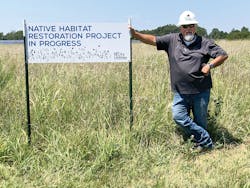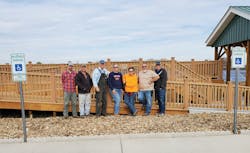City Utilities Invests in Pollinator Habitats
Many pollinators have been in decline for various reasons ranging from irresponsible pesticide usage to climate change and the destruction of their natural habitats. This isn’t limited to just honeybees, either — various other bee species, flies, beetles, butterflies, birds, and even bats provide much-needed plant pollination services. Yet more than 300,000 species of global flowering plants require pollinators to survive, as do many of the crops people need for food.
For City Utilities of Springfield (CU), its rights of way (ROWs) and service territory consist of a significant amount of land serving as a home to many different types of glade and prairie plant life. This presented an opportunity for the community-owned provider of electricity to help contribute to pollinator habitat growth and the pollination of the flora its region needs to be healthy. For CU, it quickly became clear that we needed to be part of the solution — not just today, but for the long term.
Forging Partnerships
As part of its long-term strategic plan, CU is committed to serving its customers in ways that are not only ethically and financially responsible, but also environmentally responsible. Over the past few years, many of its vegetation management team members have attended industry conferences where the subject of pollinator habitats was explored in-depth. CU also has existing partnerships with many city departments such as the Public Works Department, the Springfield-Greene County Park Board, the Missouri Community Forestry Council, Missouri Department of Conservation and Tree City USA.
One such project was the creation of a solar farm, which would not only provide solar power but also an opportunity to educate the community on the importance of this resource. For the pollinator project, CU partnered with the local Missouri Department of Conservation, Master Naturalists, the Strafford Fire Protection District and ACRT.
Creating a Community Showcase for Education
Prior to this initiative, CU had been working with national vegetation management consultant ACRT for a few years on a variety of projects throughout its service territory. This included evaluating vegetation on its ROWs, planning vegetation-related work with contractors, conducting audits on work performed, and more.
As part of its commitment to deliver reliable service to its customers and be better stewards of its ROWs, CU also engaged ACRT on an integrated vegetation management initiative, which was designed to address non-native and potentially hazardous vegetation through the application of herbicides.
Part of this project would focus on the development of pollinator plots to help support native habitat restoration at the solar farm and minimize non-native plants. The process includes two herbicide applications as well as a controlled burn prior to the land being sown with native seeds. For the controlled burn, CU worked with the Stafford Fire Protection District, its local fire department, as well as the Missouri Department of Conservation to ensure the proper procedures were followed and all aspects of the burn were managed closely.
Once the burn is complete and seeding is commenced, it will take about three years for the habitat to become established. This is because many of the plants would be perennials. After being planted, native perennials typically sleep during their first year, creep during their second year and leap on their third year.
CU wanted to expedite the process so it could use this pollinator habitat for community education, so the company first began developing a showcase area that would be established using native plants. This showcase plot measured 8 ft long by 40 ft wide, and Master Naturalists developed a planting plan with native glade and prairie species. Once complete, signage will be installed to educate the community on renewable resources, the importance of pollinators, and our interdependence with the natural world.
Planting Roots for the Future
This showcase area is just one of many areas where CU is planning to implement native plants and grasses for pollinator habitation. Over time, it is CU’s hope that with the completion of these initial pollinator habitats and the acceptance of the community, the company will be able to transform 500 to 600 acres of transmission line and several acres of distribution line ROWs into pollinator-friendly habitats.
CU is working diligently to educate the community about these initiatives. In addition to sharing information about them through various mediums, the company will also post signage along walking trails and city-owned greenways that run alongside our transmission and distribution lines. With a service territory of 320 square miles and more than 111,000 customers relying on the organization every day for everything from drinking water to their Internet connections, everything CU does is centered around improving its customers’ experiences and lives.
For more information:
ACRT | acrt.com
About the Author
Scott Gunzenhauser
Scott Gunzenhauser is the vegetation management supervisor for City Utilities of Springfield (CU), Missouri. CU is a community-owned provider of electricity, natural gas, water, broadband, and public transportation services in Southwest Missouri.


